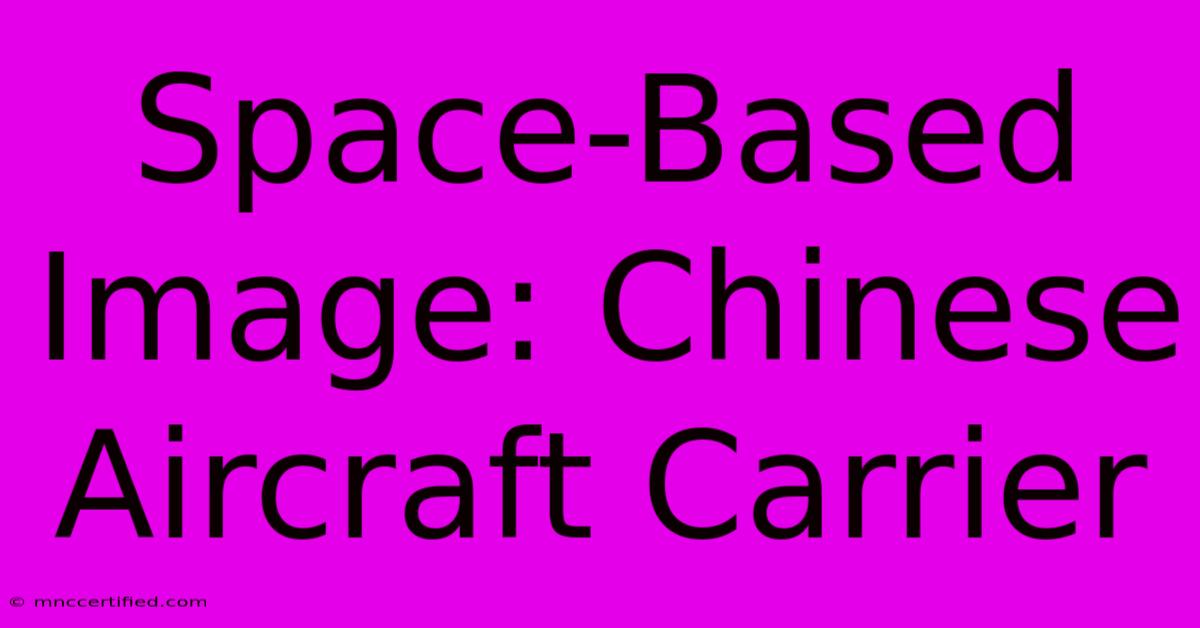Space-Based Image: Chinese Aircraft Carrier

Table of Contents
Space-Based Image: Analyzing China's Aircraft Carrier Liaoning
China's growing military might is a subject of global interest, and a key component of this is its naval power, particularly its aircraft carriers. Analyzing satellite imagery of these carriers provides crucial insights into their capabilities, deployment patterns, and the overall trajectory of China's naval ambitions. This article will delve into the specifics of space-based imagery analysis focusing on the Liaoning, China's first aircraft carrier.
Understanding the Importance of Space-Based Imagery
Space-based imagery, obtained from satellites orbiting Earth, offers unparalleled advantages in monitoring large-scale assets like aircraft carriers. Unlike other methods, satellite imagery provides:
- Unbiased Observation: Satellites offer a neutral perspective, capturing activities without the limitations or biases of on-site observation.
- Regular Monitoring: Repeated satellite passes allow for continuous tracking of the carrier's movements, deployments, and operational status.
- High-Resolution Detail: Advanced satellites provide imagery with sufficient resolution to identify aircraft types, weapons systems, and even personnel movements (though the latter requires exceptionally high resolution).
- Strategic Intelligence: Analyzing patterns of movement and activity helps experts predict future deployments and understand operational strategies.
Analyzing the Liaoning via Satellite Imagery: Key Findings
The Liaoning, a modified Kuznetsov-class carrier, has been a subject of intense scrutiny via satellite imagery analysis. This analysis reveals key details about:
1. Aircraft Deployment and Capabilities:
High-resolution satellite images allow experts to identify the types and numbers of aircraft deployed on the Liaoning. This includes J-15 fighter jets, helicopters, and early warning aircraft. Changes in aircraft deployment, observed over time via repeated satellite imagery, can indicate training exercises, upgrades, or shifts in operational doctrine. Analyzing these changes provides critical intelligence on the carrier's combat readiness.
2. Operational Activities and Movements:
Tracking the Liaoning's movements through satellite imagery provides valuable insights into its operational patterns. This includes identifying its deployment locations, the frequency of exercises, and its interaction with other naval vessels. This information is crucial for understanding China's naval strategy in the region.
3. Infrastructure and Upgrades:
Satellite images can also reveal details about the carrier's infrastructure, including potential upgrades or modifications. For example, images might show changes to the flight deck, weapon systems, or communication equipment. Detecting these changes is vital in understanding the ongoing evolution of the Liaoning's capabilities.
4. Personnel and Training:
While identifying individual personnel is usually beyond the resolution capabilities of commonly available satellite imagery, patterns of activity on deck can be interpreted to gain understanding of training exercises, crew changes, and maintenance schedules. These insights contribute to a holistic understanding of the carrier's readiness.
Challenges and Limitations of Satellite Imagery Analysis
While space-based imagery is invaluable, it's important to acknowledge its limitations:
- Weather Conditions: Cloud cover can obscure the carrier, limiting the usefulness of the imagery.
- Resolution Limitations: While resolution has improved drastically, some details might remain elusive, requiring high-resolution imagery which may not always be publicly available.
- Interpretation Bias: The interpretation of satellite imagery requires expertise and careful consideration, as biases can influence the analysis.
Conclusion: The Ongoing Importance of Space-Based Surveillance
Analyzing space-based images of the Liaoning aircraft carrier and other Chinese naval assets is a crucial element of understanding China’s evolving military power projection capabilities. The continuous monitoring provided by satellites gives valuable strategic intelligence and allows experts to track changes in the carrier's capabilities and operational deployments. While challenges exist, the benefits of space-based imagery analysis far outweigh the limitations, making it an indispensable tool for assessing global naval power dynamics. Future advancements in satellite technology will only enhance this crucial area of intelligence gathering.
Keywords: Space-based imagery, Chinese aircraft carrier, Liaoning, satellite images, military intelligence, naval power, China's military, aircraft carrier analysis, satellite technology, geopolitical analysis, naval strategy.

Thank you for visiting our website wich cover about Space-Based Image: Chinese Aircraft Carrier. We hope the information provided has been useful to you. Feel free to contact us if you have any questions or need further assistance. See you next time and dont miss to bookmark.
Featured Posts
-
East Enders Lacey Turner Excited For Baby
Nov 23, 2024
-
Charlotte Crosby Burglary Sunderland Home Targeted
Nov 23, 2024
-
Coldplay Fans Angry Over Ticket Fiasco
Nov 23, 2024
-
Bayern 3 0 Augsburg Post Match Thoughts
Nov 23, 2024
-
Reece James Injury Chelseas Anxiety
Nov 23, 2024